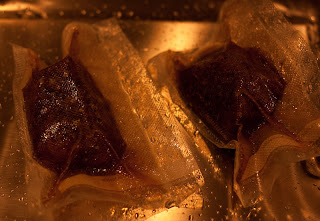Sous vide is a fancy French word that means "under vacuum". The cooking technique gets the name because food is normally vacuum sealed in a plastic bag and then placed in precisely controlled water bath. Though sous vide has been utilized in high-end restaurants for a few decades, it's a relative new method of cooking available to the home cook.
I'm almost embarrassed to even call this a technique, truth be told it's actually pretty hard to screw up cooking sous vide. Can you put food in a bag? If so, congratulation! You are an expert sous vide practitioner.
The only real skill required for successful results is planning. Sous vide cooking is
slow. You better be thinking ahead if you want to have food ready at a certain time. Cooking sous vide can take anywhere from 3 to 24 hours. As a general rule, the thicker the thing you're trying to cook is, the longer it's going to take to cook.
As a method of cooking, sous vide offers a couple of really impressive benefits. First and foremost, meat comes out moist and tender. Like,
super tender. The most tender cut of meat you've ever had (trust me, I'm not over selling this). That's because you set the water bath to the internal temperature of perfectly cooked meat and plunk the bag in there and wait until the entire cut of meat reaches that temperature. Have you ever had a 2 inch thick fillet mignon medium rare from edge-to-edge? I have - it's a transcending experience, truly sublime.
You can't overcook food using sous vide. While it may take awhile for the contents of your bag to reach your target temperature, there is no way the contents of the bag are going to get hotter than the water bath. This makes sous vide a pretty forgiving method of cooking. If you start a bit early and end up leaving your steaks in there for five or six hours instead of four they're still going to come out perfectly cooked. It's no big deal.
Since the food is vacuum sealed in plastic no flavors get out and no flavors get in. This is kind of a double edge sword. Whereas most cooking methods rely on chemical changes at high temperatures to add new flavors to food (a.k.a.
maillard reactions), sous vide does not reach high temperatures and therefore gets no benefit from those changes. On the other hand, nothing drips away and is lost either. Whatever you put in the bag is going to have a long slow intimate cook time with your food. We're talking truer flavors and literally cooking in their own juices because they got nowhere else to go.
Speaking of the juices. After cooking meat sous vide there are often juices that are naturally released but captured in the plastic bag. Under no circumstances should these juices be discarded! It turns out in addition to tender meat, sous vide makes small quantities of super broth. Taking a moment to turn these juices into a gravy is a very wise thing to do. Very wise indeed.
It's not all upside. Turns out that a lot of food benefits greatly from maillard reactions, so sous vide is not a recommended way to cook everything. Meat, seafood, and eggs are the most obvious candidates. However anything that benefits from precision might be worth a try via sous vide.
If something is not the same without a bit of searing, you can always do a quick sear after the meat has been cooked via sous vide. I'm especially interested in what happens when you cook meat sous vide, then chill it back down, and use the searing step to warm the meat back up. More experimentation is required.
There are a few
recipe souces for sous vide dishes, but as of yet, they are not all that extensive - meaning if you get a sous vide you probably should expect to do a bit of your own recipe adaptation and/or inventing.
There is a pretty heavy initial investment in equipment up front. First you need to buy a sous vide (or a commercial immersion circulater if you got really deep pockets), then you've got to buy some means of vacuum sealing. These are the two that I have, and thus far, I've been pleased with them:
Sous Vide Supreme
FoodSaver V2240

